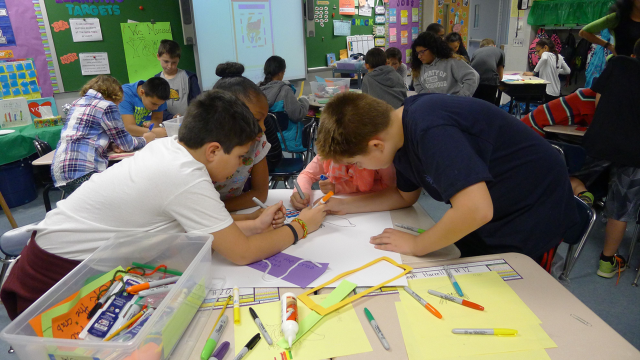
Making connections across the curriculum to promote student learning and understanding is a great idea. Sometimes, though, it takes creative thinking to recognize those connections. Last fall, Grade 5 teachers in South Huntington were looking for a way to connect hermit crabs, the 2016 Presidential Election and persuasive speaking. With help from teaching artist Lucienne Pereira, the educators decided on a STEAM project that challenged the fifth graders to create persuasive campaign posters to elect the next hermit crab leader.
For the science component of the project, the classroom teachers and students explored the physical features, adaptation and habitat of the two types (terrestrial and aquatic) of hermit crabs. They learned how the hermit crabs live in communal groups within their habitat. At the same time, the students also were following the Presidential campaigns and the learning about the power of persuasion.

Ms. Periera began her five-session arts residency with the question: “What are the persuasive elements of a powerful campaign?” To answer this question, the teaching artist and students explored the campaign posters of former Presidents (above). They considered the posters’ message as well as its graphic structure or layout. During this and subsequent group discussion, Ms. Pereira reinforced target vocabulary—slogan, candidate, image, campaign, elect, vote, persuade, and propaganda.
Next, the students were asked to imagine what a hermit crab candidate might look like and how a crab leader could be helpful to the crab community. They were shown examples of hermit crabs to guide their own drawings/interpretations (below).

Working in small groups, the students used their classmates’ drawings to arrive at a final hermit crab image. They also completed worksheets, which asked them to give their crab a name and to formulate five reasons why it deserved to be elected. Using what they’d learnt about persuasive elements and hermit crabs with their classroom teachers, the students came up with a slogan for their crab candidate.



During subsequent sessions, Ms. Pereira reviewed a campaign poster’s important components—that is, slogan, image and logo. She supported the students as they worked to apply the various persuasive and artistic elements to their campaign posters (below). For example, she addressed the positioning of the slogans on the poster and the design surrounding the poster’s images.

Some of the students used watercolors on their final posters (below).

As the students worked, their classroom teachers and teacher assistants moved from table to table to help the students (below).

Once the campaign posters were completed, they were swapped between classes. Each class voted on posters from another class (below). The teachers and students chose the poster most likely to persuade voters to elect the hermit crab. Their decision was based on the poster’s attractiveness and the crab candidate’s image, slogan and campaign promise. Each class had one winner.


Here are a few of the finished posters.


